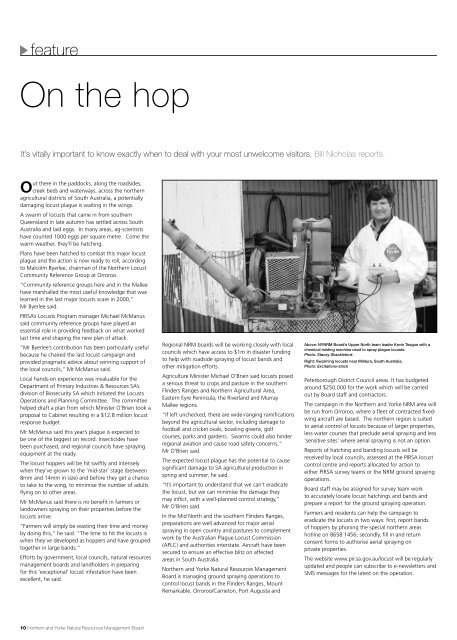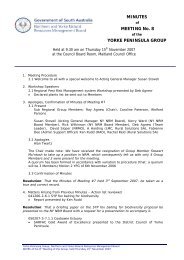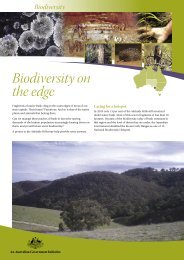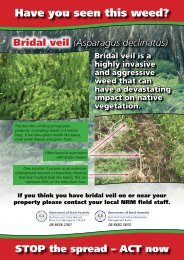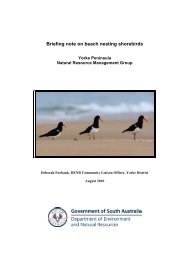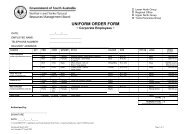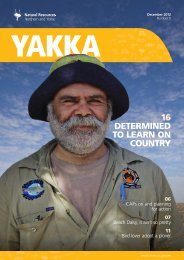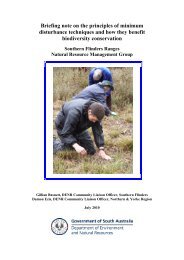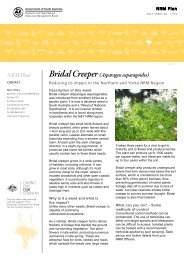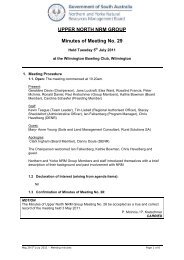Caring for country - Northern and Yorke Natural Resources ...
Caring for country - Northern and Yorke Natural Resources ...
Caring for country - Northern and Yorke Natural Resources ...
You also want an ePaper? Increase the reach of your titles
YUMPU automatically turns print PDFs into web optimized ePapers that Google loves.
4feature<br />
On the hop<br />
It’s vitally important to know exactly when to deal with your most unwelcome visitors. Bill Nicholas reports.<br />
Out there in the paddocks, along the roadsides,<br />
creek beds <strong>and</strong> waterways, across the northern<br />
agricultural districts of South Australia, a potentially<br />
damaging locust plague is waiting in the wings.<br />
A swarm of locusts that came in from southern<br />
Queensl<strong>and</strong> in late autumn has settled across South<br />
Australia <strong>and</strong> laid eggs. In many areas, ag-scientists<br />
have counted 1000 eggs per square metre. Come the<br />
warm weather, they’ll be hatching.<br />
Plans have been hatched to combat this major locust<br />
plague <strong>and</strong> the action is now ready to roll, according<br />
to Malcolm Byerlee, chairman of the <strong>Northern</strong> Locust<br />
Community Reference Group at Orroroo.<br />
“Community reference groups here <strong>and</strong> in the Mallee<br />
have marshalled the most useful knowledge that was<br />
learned in the last major locusts scare in 2000,”<br />
Mr Byerlee said.<br />
PIRSA’s Locusts Program manager Michael McManus<br />
said community reference groups have played an<br />
essential role in providing feedback on what worked<br />
last time <strong>and</strong> shaping the new plan of attack.<br />
“Mr Byerlee’s contribution has been particularly useful<br />
because he chaired the last locust campaign <strong>and</strong><br />
provided pragmatic advice about winning support of<br />
the local councils,” Mr McManus said.<br />
Local h<strong>and</strong>s-on experience was invaluable <strong>for</strong> the<br />
Department of Primary Industries & <strong>Resources</strong> SA’s<br />
division of Biosecurity SA which initiated the Locusts<br />
Operations <strong>and</strong> Planning Committee. The committee<br />
helped draft a plan from which Minister O’Brien took a<br />
proposal to Cabinet resulting in a $12.8 million locust<br />
response budget.<br />
Mr McManus said this year’s plague is expected to<br />
be one of the biggest on record. Insecticides have<br />
been purchased, <strong>and</strong> regional councils have spraying<br />
equipment at the ready.<br />
The locust hoppers will be hit swiftly <strong>and</strong> intensely<br />
when they’ve grown to the ‘mid-star’ stage (between<br />
8mm <strong>and</strong> 14mm in size) <strong>and</strong> be<strong>for</strong>e they get a chance<br />
to take to the wing, to minimise the number of adults<br />
flying on to other areas.<br />
Mr McManus said there is no benefit in farmers or<br />
l<strong>and</strong>owners spraying on their properties be<strong>for</strong>e the<br />
locusts arrive.<br />
“Farmers will simply be wasting their time <strong>and</strong> money<br />
by doing this,” he said. “The time to hit the locusts is<br />
when they’ve developed as hoppers <strong>and</strong> have grouped<br />
together in large b<strong>and</strong>s.”<br />
Ef<strong>for</strong>ts by government, local councils, natural resources<br />
management boards <strong>and</strong> l<strong>and</strong>holders in preparing<br />
<strong>for</strong> this ‘exceptional’ locust infestation have been<br />
excellent, he said.<br />
Regional NRM boards will be working closely with local<br />
councils which have access to $1m in disaster funding<br />
to help with roadside spraying of locust b<strong>and</strong>s <strong>and</strong><br />
other mitigation ef<strong>for</strong>ts.<br />
Agriculture Minister Michael O’Brien said locusts posed<br />
a serious threat to crops <strong>and</strong> pasture in the southern<br />
Flinders Ranges <strong>and</strong> <strong>Northern</strong> Agricultural Area,<br />
Eastern Eyre Peninsula, the Riverl<strong>and</strong> <strong>and</strong> Murray<br />
Mallee regions.<br />
“If left unchecked, there are wide-ranging ramifications<br />
beyond the agricultural sector, including damage to<br />
football <strong>and</strong> cricket ovals, bowling greens, golf<br />
courses, parks <strong>and</strong> gardens. Swarms could also hinder<br />
regional aviation <strong>and</strong> cause road safety concerns,”<br />
Mr O’Brien said.<br />
The expected locust plague has the potential to cause<br />
significant damage to SA agricultural production in<br />
spring <strong>and</strong> summer, he said.<br />
“It’s important to underst<strong>and</strong> that we can’t eradicate<br />
the locust, but we can minimise the damage they<br />
may inflict, with a well-planned control strategy,”<br />
Mr O’Brien said.<br />
In the Mid North <strong>and</strong> the southern Flinders Ranges,<br />
preparations are well advanced <strong>for</strong> major aerial<br />
spraying in open <strong>country</strong> <strong>and</strong> pastures to complement<br />
work by the Australian Plague Locust Commission<br />
(APLC) <strong>and</strong> authorities interstate. Aircraft have been<br />
secured to ensure an effective blitz on affected<br />
areas in South Australia.<br />
<strong>Northern</strong> <strong>and</strong> <strong>Yorke</strong> <strong>Natural</strong> <strong>Resources</strong> Management<br />
Board is managing ground spraying operations to<br />
control locust b<strong>and</strong>s in the Flinders Ranges, Mount<br />
Remarkable, Orroroo/Carrieton, Port Augusta <strong>and</strong><br />
Above: NYNRM Board’s Upper North team leader Kevin Teague with a<br />
chemical misting machine used to spray plague locusts.<br />
Photo: Stacey Shackle<strong>for</strong>d.<br />
Right: Swarming locusts near Mildura, South Australia.<br />
Photo: Excitations-stock<br />
Peterborough District Council areas. It has budgeted<br />
around $250,000 <strong>for</strong> the work which will be carried<br />
out by Board staff <strong>and</strong> contractors.<br />
The campaign in the <strong>Northern</strong> <strong>and</strong> <strong>Yorke</strong> NRM area will<br />
be run from Orroroo, where a fleet of contracted fixedwing<br />
aircraft are based. The northern region is suited<br />
to aerial control of locusts because of larger properties,<br />
less water courses that preclude aerial spraying <strong>and</strong> less<br />
‘sensitive sites’ where aerial spraying is not an option.<br />
Reports of hatching <strong>and</strong> b<strong>and</strong>ing locusts will be<br />
received by local councils, assessed at the PIRSA locust<br />
control centre <strong>and</strong> reports allocated <strong>for</strong> action to<br />
either PIRSA survey teams or the NRM ground spraying<br />
operations.<br />
Board staff may be assigned <strong>for</strong> survey team work<br />
to accurately locate locust hatchings <strong>and</strong> b<strong>and</strong>s <strong>and</strong><br />
prepare a report <strong>for</strong> the ground spraying operation.<br />
Farmers <strong>and</strong> residents can help the campaign to<br />
eradicate the locusts in two ways: first, report b<strong>and</strong>s<br />
of hoppers by phoning the special northern areas<br />
hotline on 8658 1456; secondly, fill in <strong>and</strong> return<br />
consent <strong>for</strong>ms to authorise aerial spraying on<br />
private properties.<br />
The website www.pir.sa.gov.au/locust will be regularly<br />
updated <strong>and</strong> people can subscribe to e-newsletters <strong>and</strong><br />
SMS messages <strong>for</strong> the latest on the operation.<br />
10 <strong>Northern</strong> <strong>and</strong> <strong>Yorke</strong> <strong>Natural</strong> <strong>Resources</strong> Management Board


